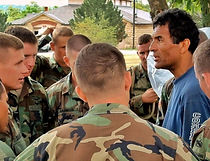Traditional martial arts training typically requires many years of dedicated practice under the direct supervision of a highly skilled instructor in order to produce a high level of real-world fighting skills. There are some who maintain that even decades of practice in some types of martial arts do not produce real-world fighting skills. Practice may very well make perfect, but “perfecting” ineffective or unrealistic techniques will not make one’s street survival perfect.
Prior to 1995, the U.S. Army embraced techniques from several styles of traditional martial arts like karate, judo, and jūjitsu. The Army also had several instructors with backgrounds in combat sports like boxing and wrestling.

The figure to the left is an example from the 1992 Army Combatives manual. The technique is a variation on a shoulder lock from traditional jūjitsu called ude garami. This joint lock is very similar to the “Americana” from modern Brazilian jiu jitsu, however the Americana is typically applied in ground grappling.
Many criticized techniques from traditional martial arts in military training as a waste of time. The techniques were often considered unrealistic, or too difficult to master in a short period of training. After all, even today, Army basic training only provides 15 hours of hand-to-hand combat.

In November 1993 came the first Ultimate Fighting Championship. Royce Gracie demonstrated to the world that Gracie jiu jitsu could dominate highly trained fighters in other martial arts-even though these fighters were all 20 or more pounds bigger than Royce. Gracie didn’t win any of his fights by being the biggest or fittest fighter; he won using strategy and intelligence.

By 1995, Rorion and Royce Gracie were teaching Gracie jiu jitsu to U.S. Army green berets. Green beret Matt Larsen was instrumental in arranging soldiers training in Gracie jiu jitsu. Many Army Ranger instructors also traveled to the (then) Gracie Academy in Torrance, CA to learn Gracie jiu jitsu techniques that would be applicable in combat.
Gracie jiu jitsu is comprised of positional controls, escapes, joint locks, chokes, sweeps, throws, and weapons defenses that are over 600 in number. Challenge fights and real street fights taught the Gracies that of all of those techniques, only 36 techniques tended to be used commonly and with the highest degree of success. A set of 36 techniques proved to be a manageable alternative to trying to learn an entire system of martial arts in less than 20 hours of training. This was the birth of Gracie Combatives.
One aspect of Gracie jiu jitsu that the techniques allow such control and scaling of the actual violence imposed, that practitioners can train at high levels of intensity that are close to the energy of real combat, and do it relatively safely. To Larsen, this made sense for training soldiers. The fact that soldiers can train at nearly 100% intensity was an additional aspect of Gracie jiu jitsu that made sense for military combatives training.
High intensity training was not new from the Gracie style. At the Kodokan in Tokyo, judo had been using a training technique known as randori since the 1880s. Randori is a type of sparring in which two students actively try to throw or submit their partner while both actively defend the attacks and make their own attacks in an attempt to prevail in the match. This type of realistic energy was the basis for how Kodokan trained students dominated competitions in Japan for many years into the late 1800s.

Gracie combatives offers soldiers a manageable set of techniques that were based on a small set of consistent principles, and it could be practiced at an intensity that closely simulated the violence of combat. To this day, Gracie jiu jitsu makes up a majority of the technique content in Army Combatives.

The Combatives framework was soon incorporated into the Gracie formula for self-defense instruction for civilians. People who really need Gracie jiu jitsu for self-defense shouldn’t have to train for 8 or 10 years before they have useful skills to help them survive a violent street encounter. The same 36 techniques that proved relatively easy to learn in a relatively short period of time for soldiers showed to be the same techniques that anyone can learn to be ready to save their own life against a violent attacker.

The Combatives program was a natural basis for the Gracie Survival Tactics (GST) program for law enforcement. The GST program is a slight modification of the same principles that lead to the development of the Combatives program. The same principles of distance management, connection, and control establish the basis of techniques for police arrest and control.
Lakewood Jiu Jitsu Academy offers opportunities for civilians interested in effective self-defense as well as police officers or military personnel who want to just keep their training relevant to their profession and maintain life saving skills to always be ready.
